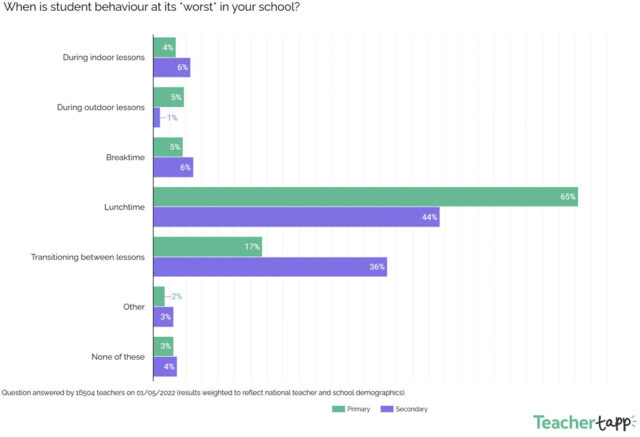The Lunchtime Listen report, published in May 2025 by School Surveys, set out to explore how pupils across England experience their school lunch break. Over 11,000 primary and secondary pupils from 43 schools took part, making it one of the most extensive pupil voice projects of its kind in recent years.
Lunchtimes are incredibly complex; crucial for eating (and eating well, particularly pertinent for pupils who rely on free school meals), an opportunity to be outside in fresh air and to exercise and socialise with peers. Lunchtimes today might provide the only ‘free’ time when socialising with friends is not dominated by mobile phones or social media.
Yet, lunchtimes are often difficult for schools. The events that occur during the lunch ‘hour’ (often much shorter now, too), directly impact the afternoon, with 60% of primary school teachers using lesson time to resolve playground issues on a typical day. The report explores challenges around finding sufficient time, space, supervision and resources to manage lunchtime effectively.
Much of the findings focus around three key areas: behaviour, food and toilets.
Behaviour
55% of teachers report behaviour in their schools to be at its worst during lunchtimes.

Pupil voice echoes this, with only just over half (52%) of pupils agreeing that children at their school behaved well, for all or most of the time at lunchtime. What then, do the other 48% of pupils perceive or experience?
Nearly half of teachers (49% in primary, 43% in secondary) also said there is not enough adult supervision at lunchtimes and these are the times when behaviour is most likely to break down.
Food
Only 51% of primary and 48% of secondary pupils reported that they found school meals tasty, with even fewer saying the meals were healthy (35% primary, 10% secondary) or filling enough (30% primary, 24% secondary).
Teachers echoed these concerns, with 41% saying children in their class are too hungry to learn, rising to 68% in schools with high levels of Free School Meal eligibility. Pupils themselves most commonly called for better food as the top improvement to their lunchtime experience..
47% of pupils also expressed a desire for quieter spaces to eat lunch. It was the top improvement wish for 12% of pupils. Of common problems in the lunch hall, the other stand-out issue was a lack of seats (cited by 57% of secondary pupils).
Toilets
Only a third of pupils said that the toilets in their school were “OK” all or most of the time. 18% of primary pupils and 25% of secondary pupils said their toilets were “not OK at all”. Poor toilet provision, particularly where facilities are tucked away or poorly supervised, is linked to increased behavioural incidents.
These concerns mirror a wider conversation in education about how the school day has changed. Research from the Raising the Nation Play Commission shows that school lunchtimes have been cut by an average of 19 minutes over the past twenty years. Less time, less space and fewer staff make it harder to ensure lunchtimes are calm, safe and inclusive.
Solutions?
Findings confirm that lunchtimes involve an incredibly complex mixture of things going on and as such, improving the lunchtime experience requires a coordinated approach. The Lunchtime Listen survey set out to establish factors across multiple areas, including:
- Lunch itself – How is the food, and do they have enough to eat?
- Time to eat & relax – Do they feel rushed or have enough downtime?
- Outdoor space & play – Are they active, engaged, and happy?
- Activities & clubs – Are the options meeting their needs?
- Social experience – Do they feel included and safe?
Findings confirm that lunchtimes involve an incredibly complex mixture of things going on and as such, improving the lunchtime experience requires a coordinated approach. The Lunchtime Listen survey set out to establish factors across multiple areas, including:
- Do you know which year group is the least positive about lunchtimes and why?
- Can you review your meals provision? Would it make sense to do a follow up survey focused on food?
- What role does your School Council play in driving activities for lunchtimes?
- Can pupils gain valuable experience and skills in taking on lunchtime responsibilities, for example running activities or becoming Peer Mediators?
- Are your toilets fit for purpose? Are you making them safely available at the right times of day?
(The Lunchtime Listen Report)
These points are interconnected and speak to how intricate the lunch period really is. This time is a carefully balanced part of the school day with implications for pupil wellbeing, learning and relationships.
Schools tackling lunchtime challenges often begin with changes to supervision, routines and lunch service organisation. Some introduce staggered lunchtimes or train pupil lunch leaders to model positive behaviour while others create quieter zones or make changes to signage and flow to reduce crowding. Yet, even the best staffing and systems can be undermined by poor layout or outdated infrastructure. This is where design becomes a powerful tool for change.
Building architecture and layout has a clear impact on behaviour, wellbeing and learning in schools. Outdated infrastructure and crowded, dark or ‘hidden’ spaces are consistently linked to bullying, anti-social behaviour and discomfort. Well-designed schools improve visibility, safety and navigation, creating spaces where pupils feel more secure and are better able to engage and self-regulate.
The Regis School, for example, worked with ZONE Design. Build to integrate WC facilities directly off its new dining space; open-plan, visible and easy to supervise. As a result, lunchtimes have been transformed, with 1600 pupils moving smoothly through ample dining facilities to collect their meals in just 22 minutes. Since the installation, there have been NO incidents in the adjoining toilets. Here, the right design is supporting pupils and staff to have better lunchtimes.
For schools considering improvements, The Lunchtime Listen provides a vital evidence base, one that recognises lunchtime as a key part of the school day and supports schools in pinpointing key areas for reflection and redesign. You can also find out more about the ZONE Design. Build projects that are helping schools to reimagine their lunchtime offering, in schools across the UK, here.

